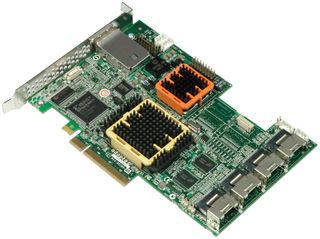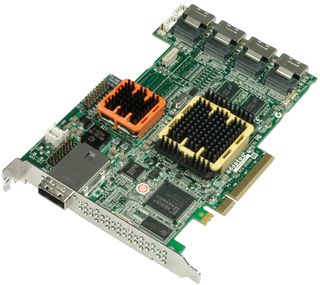Roundup: Three 16-Port Enterprise SAS Controllers
Adaptec RAID 51645

Adaptec currently offers three product lines: the entry-level 2-series, the value-class 3-series, and the performance line, which is the 5-series. Being the speed freaks that we are, we looked at one of the performance products.
We find Adaptec’s naming and nomenclature to be very straightforward. The first digit—2, 3 or 5—represents the product family, as mentioned above. The middle three characters indicate the number of internal and external ports (244 means 24 external and 4 internal ports, for instance). Finally, the last digit stands for the technology used. A 5 represents Unified Serial controllers, which can handle SAS and SATA drives. We received an Adaptec RAID 51645 for review, which comes with 16 internal and 4 external ports.
We looked at the Adaptec 5-series in April 2008 and found that the RAID 5805 card offers great performance and a comprehensive feature set at an acceptable price point. Adaptec says that it outperforms the competition by as much as five times, a claim that the high-end 51645 controller will have to prove.
Details

The RAID 51645 is based on Adaptec’s dual-core RAID on Chip (ROC) architecture, running at 1.2 GHz. It has access to a 512 MB DDR2 cache repository and connects to the host PC via eight PCI Express lanes. Four SFF-8087 connectors provide four SAS ports internally, and an additional SFF-8088 connector is available for four additional external connections. Adaptec supports all popular RAID modes, including RAID 0, 1, 1E, 5, 5EE, 6, 10, 50, and 60 plus JBOD. The “EE” represents distributed hot spares, which are used instead of standing by.
Adaptec supports spinning down drives through its power management engine, which can be defined individually for each array. System drives can be excluded if necessary. There is also an optional battery backup unit. Check out the Adaptec Web site for the full specifications, or have a look at the comparison table later on in this piece.
Firmware Update
Stay on the Cutting Edge
Join the experts who read Tom's Hardware for the inside track on enthusiast PC tech news — and have for over 25 years. We'll send breaking news and in-depth reviews of CPUs, GPUs, AI, maker hardware and more straight to your inbox.

To upgrade the controller firmware you have to go to “Direct Attached Storage”, because this is the only way to make the menu item “Actions” > “Upgrade controller images” available.


Current page: Adaptec RAID 51645
Prev Page 4x4 Ports: Multi-Lane Technology, Enclosures, Connections Next Page Adaptec Storage ManagerMost Popular

